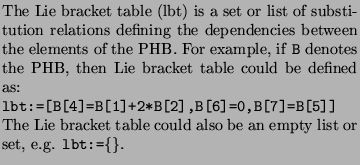|
Compute the Taylor series expansion of
eadr, reduces the Lie brackets in the expression to elements in the PHB and further simplifies it according to the supplied Lie bracket table. |
Syntax e:=ead(x,y,n);
e:=eadr(x,y,n,B,lbt);
Description
Compute the Taylor series expansion of the exponential
formula (9):
up to terms of order eadr, reduces the Lie brackets in the expression to elements in the PHB and further simplifies the expression according to the supplied Lie bracket table. If the Lie bracket table is an empty list or set, no additional simplifications are carried out. |
Arguments
eadr additionally requires:


Examples
The Taylor series expansion for exponential of the operator
> z:=ead(f1,f0,3);
z := f0~ + (f1~ &* f0~) + 1/2 (f1~ &* (f1~ &* f0~))
+ 1/6 (f1~ &* (f1~ &* (f1~ &* f0~)))
which simplified using the reduceLB command results in
> reduceLB(z,B);
f0~ - (f0~ &* f1~) - 1/2 (f1~ &* (f0~ &* f1~))
- 1/6 (f1~ &* (f1~ &* (f0~ &* f1~)))
|
See Also
ad.
|
